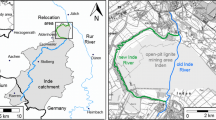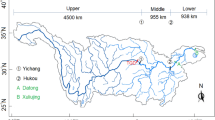Abstract
Hydromorphological alterations of large rivers are evident and have to be related to multiple anthropogenic pressures. The presented results of an integrated study concerning the actual status of the hydromorphology of the Danube River Basin show that in particular, the sediment regime features a heavily disturbed system at various scales. Combined impacts of flood protection, navigation and hydropower measures applied over a long period of time have been identified based on the river-scaling concept (RSC) for being responsible for these specific alterations (lack of bed load and suspended load in the remaining free-flowing sections). Moreover, long sections of the Danube River have been narrowed, channelized, disconnected from floodplains and morphologically degraded over the last 200 years. This has caused increased bottom shear stresses, increased sediment transport capacities and in addition a lack of lateral self-forming processes and corresponding reduced morphodynamics in the non-impounded sections. As a consequence of both longitudinal and lateral disturbances of the sediment supply and additional impacts of the channelization, the remaining free-flowing sections are subject to various forms of river bed degradation. Such degradation or river bed incision leads to a loss of instream structures in general, with a disappearance of gravel bars at the Upper Danube, and changes of sandbars at the Lower Danube. Hence, for river systems and large river basins, it has to be stated that the preservation and restoration of morphodynamics is one of the most relevant issues for river engineering and ecology. This has to be considered especially for the implementation of legal directives and/or future river basin management plans.
Access this chapter
Tax calculation will be finalised at checkout
Purchases are for personal use only
Similar content being viewed by others
References
Habersack H, Piégay H (2008) River restoration in the Alps and their surroundings: past experience and future challenges. In: Habersack H, Piégay H, Rinaldi M (eds) Gravel-bed rivers VI: from process understanding to river restoration. Elsevier, Amsterdam
Liska I, Wagner F, Slobodnik J (2008) Joint Danube Survey 2, Final scientific report. ICPDR. http://www.icpdr.org/main/activities-projects/joint-danube-survey-2
ICPDR (2009) Danube river basin district management plan. International Commission for the Protection of the Danube River, 109 pp
Schiemer F, Guti G, Keckeis H, Staras M (2004) Ecological status and problems of the Danube river and its fish fauna: a review. In: Welcomme RL, Petr T (eds) Proceedings of the IInd international symposium on the management of large rivers for fisheries; sustaining livelihoods and biodiversity in the new millennium, vol 1. FAO Regional Office for Asia and the Pacific, Phnom Penh, pp 273–299
Lóczy D (2007) The Danube: morphology, evolution, and environmental issues. In: Gupta A (ed) Large rivers – geomorphology and management. Wiley, Chichester, p 25
Domokos M, Neppel F, Somogyi S (2000) Paläogeographische Geschichte der Donau und ihres Einzugsgebietes. Hydrologie und Wasserbewirtschaftung 44: H.4
UNDP/GEF (2006) Danube regional project. Updated transboundary diagnostic analysis, based on EU water framework directive analysis report. UNDP/GEF ICPDR and Global Environment Facility, 81 pp
Habersack H (2000) The river-scaling concept (RSC): a basis for ecological assessments. Hydrobiologia 422–423:49–60
Habersack H, Jäger E, Hauer C (2013) The status of the Danube River sediment regime and morphology as a basis for future basin management. Int J River Basin Manage 11(2):153–166
Danube Commission (2005) Hydrological reference book of the Danube, 1921–2001. Budapest, 360 pp
ICPDR (2004) The Danube River Basin District. River basin characteristics, impact of human activities and economic analysis required under Article 5, Annex II and Annex III, and inventory of protected areas required under Article 6, Annex IV of the EU Water Framework Directive (2000/60/EC) (WFD Roof Report 2004). International Commission for the Protection of the Danube River, 175 pp
Holubová K, Capeková Z, Szolgay J (2004) Impact of hydropower schemes on bed load regime and channel morphology of the Danube river. In: Greco M, Carravetta A, della Morte R (eds) Proceedings of the IInd international conference on fluvial hydraulics, river flow 2004. Taylor & Francis, Naples (Italy), pp 135–142
Schwarz U, Babic-Mladenovic M, Bondar C, Gergov G, Holubova K, Modev S, Rákóczi L, Rast G, Steindl J, Sorin T, Anna TE (2008) Assessment of the balance and management of sediments of the Danube waterway, current status, problems and recommendations for actions. World Wide Fund for Nature, Vienna, 59 pp
ICPDR (2006) Management problems of sediment quality and quantity in the Danube River basin, Draft Issue Paper. 30 pp
Habersack H, Jäger E, Hauer C, Schwarz U, Zinke A, Vogel B, Simoner M (2010) Integrative study on hydromorphological alterations on the Danube. Platina – platform for the implementation of Naiades, p 218
Dogterom J (2001) Assessment practices and environmental status of 10 transboundary rivers in Europe. In: International water assessment centre under the UNECE convention on protection and use of transboundary watercourses and international lakes. Helsinki, 1992. International Water Assessment Centre/riza, 141 pp
Schmautz M, Aufleger M, Strobl T (2000) Wissenschaftliche Untersuchung der Geschiebe- und Eintiefungsproblematik der österreichischen Donau. Gutachten im Auftrag der Verbund-AHP AG. Technische Universität München – Lehrstuhl und Versuchsanstalt für Wasserbau und Wasserwirtschaft, 194 pp
Jungwirth M, Haidvogl G, Moog O, Muhar S, Schmutz S (2003) Angewandte Fischökologie an Fließgewässern. Facultas Universitätsverlag, Wien
Technum NV, Trapec SA, Tractebel Development Engineering SA, Compagnie Nationale Du Rhone and Safege (2008) Preliminary design report section I. Technical assistance for the improvement of navigation conditions on the Romanian-Bulgarian common sector of the Danube and accompanying studies, ISPA programme (incl. 9 annexes). Ministry of Transports in Romania, 283 pp
Habersack H (2007) Innovative river management – combining ecology, navigation and river engineering. Contribution paper – Joint statement. 4 pp
Krausmann F, Haberl H, Schulz NB, Erb K-H, Darge E, Gaube V (2003) Land-use change and socio-economic metabolism in Austria, part I: driving forces of land-use change: 1950–1995. Land Use Policy 20(1):1–20
Via Donau (2007) Manual on Danube Navigation. Viadonau – Österreichische Wasserstraßen Ges.m.b.H.
Hohensinner S (2008) Rekonstruktion ursprünglicher Lebensraumverhältnisse der Fluss-Auen-Biozönose der Donau im Machland auf Basis der morphologischen Entwicklung von 1715–1991. Dissertation, Universität für Bodenkultur Wien/Department für Wasser, Atmosphäre und Umwelt | Institut für Hydrobiologie und Gewässermanagement p 307, Wien, Österreich
Donau Consult (2006) Flussbauliches Gesamtprojekt Donau östlich von Wien – Generelles Projekt (Technischer Bericht). DonauConsult Ziviltechnikergesellschaft m.b.H, 183 pp
Goda L, Kalocsa B, Tamás EA (2007) River bed erosion on the Hungarian section of the Danube. J Environ Sci Sustain Soc 1:47–54
Bondar C, Teodor SM (2008) The evaluation of the balance and the management of sediments in the shipping portion of the Danube course. Text prepared in course of the project. Assessment of the balance and management of sediments of the Danube waterway (Schwarz et al. 2008) World Wide Fund for Nature, Vienna, 59 pp
Habersack H, Liedermann M, Tritthart M (2007) Restoring large rivers – the integrated Danube River project. In: Jowett I, Biggs B (eds) Sixth international symposium on ecohydraulics, Bridging the gap between hydraulics and biology. Christchurch, p 4
Danube Pollution Reduction Programme (1999) Strategic action plan for the Danube river basin 1995–2005, REVISION 1999, Strategic action plan for the Danube river basin 1995–2005, Revision 1999. ICPDR, Vienna, 180 pp
Günther-Diringer D (2000) Evaluation of wetlands and floodplain areas in the Danube river basin. In: Nijland HJ, Cals MJR (eds) Proceedings of the IInd ECRR international conference on river restoration in Europe 2000. Institute for Inland Water Management and Waste Water Treatment/RIZA Lelystad (Pub.), Wageningen, pp 91–94
Schober B, Hauer C, Habersack H (2015) A novel assessment of the role of Danube floodplains in flood hazard reduction (FEM-method). Nat Hazards 75:33–50
Hauer C, Schober B, Habersack H (2012) Impact analysis of river morphology and roughness variability on hydropeaking based on numerical modelling. Hydrol Processes. doi:10.1002/hyp.9519
Kroiss H (2005) Nutrient management in the Danube basin and its impact on the Black Sea, Institute for Water Quality and Waste Management, Vienna University for Technology. Danubs final report. 69 pp
Feyen L, Dankers R, Barredo JI, Kalas M, Bódis K, De Roo A, Lavalle C (2006) PESETA – Projections of economic impacts of climate change in sector of Europe based on bottom-up analysis, flood risk in Europe in a changing climate. Institute of Environment and Sustainability. European Communities, 22 pp
Habersack H, Krapesch G, Holzmann H, Koboltschnig G, Pinker O (2006) StartClim 2004D Assoziiertes Projekt, Hitze- und Dürrefolgen für die Wasserwirtschaft Österreichs. Universität für Bodenkultur/Institut für Wasserwirtschaft, Hydrobiologie und konstruktiven Wasserbau. Verbund, 72 pp
Acknowledgements
The authors want to thank the European Commission for financing the TREN/FP7TR/218362/“PLATINA”– project. Additionally, the financial support by the Federal Ministry of Economy, Family and Youth and the National Foundation of Research, Technology and Development is gratefully acknowledged. Moreover, the authors are grateful to Bernhard Schober and Daniel Haspel for their contribution in editing graphics and tables. The authors want to thank Taylor & Francis to grant non-exclusive permission to reproduce the major part of the article reference 9, to be found in www.tandfonline.com.
Author information
Authors and Affiliations
Corresponding author
Editor information
Editors and Affiliations
Rights and permissions
Copyright information
© 2014 Springer-Verlag Berlin Heidelberg
About this chapter
Cite this chapter
Habersack, H., Jäger, E., Hauer, C. (2014). Danube River Sediment Transport and Morphodynamics. In: Liska, I. (eds) The Danube River Basin. The Handbook of Environmental Chemistry, vol 39. Springer, Berlin, Heidelberg. https://doi.org/10.1007/698_2014_314
Download citation
DOI: https://doi.org/10.1007/698_2014_314
Published:
Publisher Name: Springer, Berlin, Heidelberg
Print ISBN: 978-3-662-47738-0
Online ISBN: 978-3-662-47739-7
eBook Packages: Earth and Environmental ScienceEarth and Environmental Science (R0)




